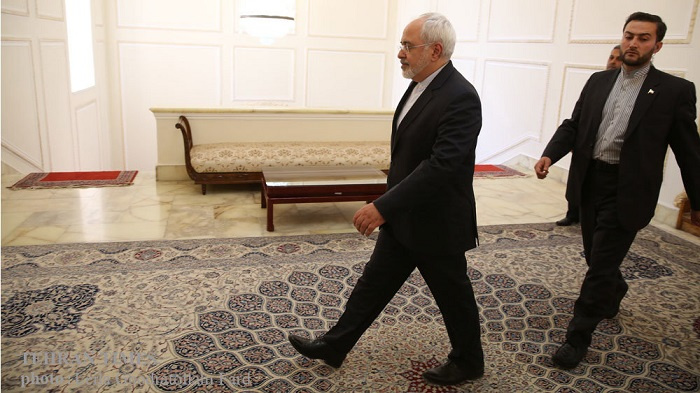Zarif’s Upper Hand in Meeting with Tillerson

Four years ago these days, New York City hosted the first round of nuclear talks of the post-Ahmadinejad era. The man who had just taken presidential office in Tehran had promised cooperation with the world, and that not only the centrifuges would continue to spin, but also the wheels of citizens' livelihoods.
During the talks that took place shortly after Rouhani’s election in 2013, the Iranian side, headed by the new foreign minister Javad Zarif, sat face to face with the foreign ministers of the six world powers, dubbed the P5+1 group. A hundred days later, the talks led to the Geneva agreement Action Plan. Twenty-two months later, they culminated in an accord, later to be called the greatest diplomatic achievement of the recent decades by international standards.
Even though the settlement of the nuclear dispute had already begun a year before Rouhani’s presidency, in secret meetings between representatives of Iran and the US, as mediated by Oman) Rouhani’s election provided a unique opportunity for a diplomatic solution. Iran resolved the dossier successfully, in what was perhaps the most critical diplomatic deadlock since Iran’s nationalization of the oil industry sixty years earlier.
Obviously, the US was the P5+1 group’s lead actor with a key role in the talks. President Barack Obama had made a diplomatic solution to the nuclear issue a priority of his foreign policy strategy. In doing so, he appointed John Kerry as Secretary of State in lieu of Hillary Clinton who was, under the influence of the pro-Israeli lobbies, uncooperative. More importantly, he countered all the efforts made by Benjamin Netanyahu to sabotage the talks, going so far as declining to meet the Israeli PM during the latter’s Washington visit for the first time in the history of US-Israeli relation. Obama openly said who would not be receiving Prime Minister Netanyahu before the conclusion of talks.
Some member of the Iranian team of negotiators have stressed in their interviews the role and significance of the US and Kerry’s flexibility during the nuclear talks. Unfortunately, Iran has lost many opportunities during Obama’s presidential terms for the better implementation of the JCPOA or even negotiation for some foreign policy challenges in the region and the world.
Donald Trump’s presidency was a disaster for the JCPOA in itself. One cannot forget the terms he used in reference to the accord during his campaign, calling it 'the worst agreement he had ever seen'. It was predictable that under his administration and military-security team, the implementation of the JCPOA would have a bumpy ride. However, Trump had to face serious restrictions in keeping his promises of dealing with the nuclear agreement. The Trump team spared no effort to create serious hindrances for the implementation process. Nonetheless, everyone knew the deal was not a reversible bilateral agreement between Iran and the US. The deal was established firmly, endorsed by 5 world powers (other than the US) and the UN Security Council Resolution 2231. Therefore, the new White House team’s efforts to disrupt the deal or launch a renegotiation on its provisions have met serious opposition by the members of the P5+1 group and other states. Moreover, the world has now recognized the nuclear deal as an example for conflict resolution in other international issues and is recommending the model for other global challenges.
Rouhani and Zarif are now visiting New York to attend this year’s General Assembly of the United Nations. On the sidelines of the assembly, foreign ministers of the P5+1 group and Iran will meet, a first for the new Secretary of State. If one wants to draw a comparison between the upcoming meeting with the first round of talks in September 2013, the completely different statuses of the US and Iran could be easily observed: four years ago, Zarif attended the talks while Iran was wrestling with oppressive, crippling sanctions imposed by UNSC resolution, a global consensus against itself, where most countries either refused to have relations with Iran or sought concessions for any kind of cooperation. Now, Zarif meets his counterparts, a few days after IAEA Director General Yukiya Amano confirmed in his report Iran was abiding by its commitments under the deal. IAEA is undersigning and backing Iran’s commitment while the US is isolated due to Trump’s insensible and adventurous approaches. One could dare say it is the first time US is becoming isolated in an international issue. At least, Iran enjoys support from five of the six world powers and their serious opposition to United States’ anti-deal policies.
I have previously written that talks attended by Zarif and the State Secretary broke a taboo that had overshadowed mutual relations for more than 30 years. Perhaps the telephone conversation between Obama and Rouhani, which quickly made world headlines, came even closer. We have seen that the conversation did not dent the Islamic Revolution’s solemnity. Neither was Zarif subdued by John Kerry. Quite contrary to the rhetoric used by anti-deal forces inside the country, Iran’s bargaining power was praised by the world, including Americans.
It is clear that Trump and his team are beating the air by trying to dismantle the deal. Tillerson’s participation in the upcoming meeting is a good opportunity for Zarif to show the legitimacy of the deal and its non-negotiable nature, not only in talks with the P5+1 group, but in a bilateral meeting with the new Secretary of State. Iran’s nuclear dossier is closed through diplomacy. In 22 months of intensive talks, Zarif and Kerry repeatedly met to talk. There is no justification for repeating those talks between Zarif and Tillerson.

